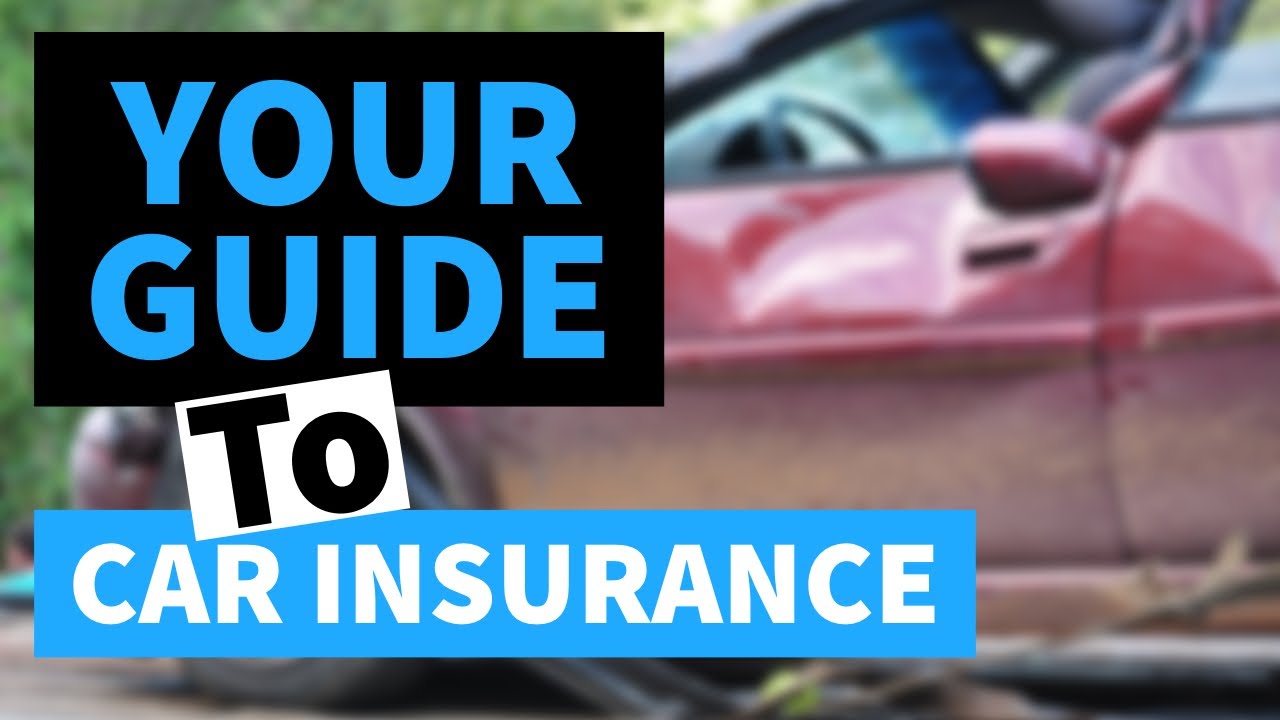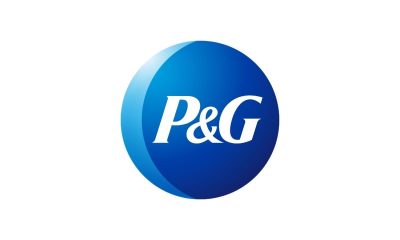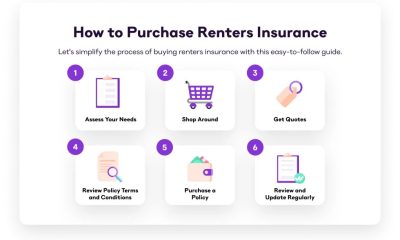Insurance
The Best Car Insurance Guide 2024 | USA

When accidents occur, car insurance protects your cash by helping to cover the following expenses. The amount of coverage you have is determined by your specific policy, but pricing and terms vary. That is why it is critical to select the best vehicle insurance policy for your specific needs.
In this tutorial, we’ll go over the many forms of car insurance and how to choose the one that’s right for you. Then we’ll go over how to obtain car insurance, including potential costs and ways to save money. Finally, we’ll go over how to make a claim with your car’s insurance carrier in the event of an accident or other damage.
- What Is Car Insurance?
Car insurance, like other types of insurance, protects you from financial losses caused by accidents, theft, and weather-related disasters. A car insurance policy is essentially a contract between you and an insurance company in which you agree to pay premiums in exchange for the company covering the costs of medical bills, vehicle repairs, and other property damage. The language of that contract specifies exactly what is covered by your insurance coverage.
- How Much Car Insurance Do You Need?
The most important aspect in determining how much insurance you need is where you live. Each state (and the District of Columbia) has legal requirements for specific types and levels of car insurance coverage. There are two exceptions.
- New Hampshire doesn’t require car insurance.
- Virginia lets drivers opt out of buying car insurance by paying a $500 fee. Virginia Department of Motor Vehicles. “Insurance Requirements.”
However, both states have financial responsibility rules, which means you may be held accountable for damages if you cause an accident. Without insurance, you will also be responsible for covering medical expenses and repair fees.
If you have a car loan or lease, you may be required to meet lender criteria in addition to state regulations. Because the lender has an interest in the vehicle, they may require you to carry specific types or levels of coverage.
Even if you own a car outright, you may want to consider a policy that exceeds the state minimums. A greater coverage level may be more expensive, but it will provide additional protection in the event of an accident, and extra coverages may help cover major repair expenditures that you are unable to pay out of pocket.
Types of Car Insurance
A car insurance policy is often comprised of several types of coverage. Your policy’s makeup is determined by both state laws and your own preferences for optional coverages. Understanding the different types of auto insurance will help you put up a coverage that meets your needs.
- Liability Coverage
Almost every state mandates a minimum amount of liability insurance, which covers other people’s expenses resulting from an accident you caused and can protect you financially from personal claims. It comes in two types:
- Bodily injury liability: This insurance covers expenses related to injuries, such as medical bills and missed wages. It is needed in the District of Columbia and 49 states, including New Hampshire and Virginia, if you choose to get vehicle insurance. Progressive, “Car Insurance Requirements by State.” Florida is the only state that does not require bodily injury liability coverage.
- Property damage liability: This insurance covers the costs of repairing or replacing damaged cars and property, such as a fence or mailbox. Property damage liability is required in all states, including New Hampshire and Virginia, if you purchase auto insurance.
“Insurance Requirements.” Virginia Department of Motor Vehicles.
The amount of liability insurance in a policy is commonly represented by three numbers: physical injury per person and per accident, and property damage per accident. For example, California’s minimum required liability insurance is stated as “15/30/5,” which translates to:
- $15,000 per injured person
- $30,000 per accident if more than one person is injured
- $5,000 for damaged property
Medical Payments (MedPay) or Personal Injury Protection (PIP) Coverage
Medical payments (MedPay) and personal injury protection (PIP) cover medical expenditures for you and your passengers following an accident, regardless of fault, up to the limits of your insurance. Some insurance may additionally cover funeral costs. In some areas, PIP may also pay lost wages and child care expenses while you are injured. Oregon State Legislature.
Some states require PIP, while others give it as an optional endorsement. For example, while PIP coverage is required in Massachusetts, you can opt out of it in Texas by writing to the insurance carrier. MedPay is voluntary in most states, but mandated in Maine. It is also required in New Hampshire if you get car insurance.
- Uninsured and Underinsured Motorists Coverage
Uninsured motorist coverage protects you if you are involved in an accident with a driver who is not insured. Similarly, underinsured motorist coverage covers you if the at-fault driver carries some insurance, such as the state-required minimum liability amounts, but not enough to cover your losses. Uninsured and underinsured motorist coverage, like liability insurance, is divided into two parts: bodily injury, which pays for medical bills, and property damage, which covers repair costs.
Some states require uninsured motorist coverage, while others make it voluntary. Some states require underinsured motorist coverage, while others make it voluntary. Some states combine these policies into uninsured/underinsured motorist coverageThe details and conditions of coverage vary depending on state laws and insurance policies, so study the fine print and contact your insurance agent if you have any questions.
- Collision and Comprehensive Coverage
If you are involved in an accident that is not your fault, the other driver’s insurance (or your uninsured motorist policy) will cover the cost of repairing your vehicle. However, if your vehicle is damaged in an accident that is determined to be your fault, or by a natural disaster, you must rely on your own insurance. This is where two optional but necessary coverages come into play. Collision coverage: helps pay for damage caused by an accident with another vehicle or an object, such as a fence or tree. Comprehensive coverage helps pay for damage caused by catastrophes other than accidents, such as fallen trees, floods, or fires.
- Other Types of Coverage
Depending on your state regulations and insurance carrier, you may be able to add additional coverages to your policy, such as Liberty Mutual. “Car Insurance Coverage Types.”
- Roadside assistance coverage
- Gap insurance
- Rental car reimbursement coverage
- Rideshare insurance
- Accident forgiveness
- Original equipment manufacturer (OEM) coverage
- Custom equipment coverage, which pays to replace modifications like an upgraded stereo, custom paint job, or off-road equipment
- Pet injury coverage
Coverage is also available for exceptional situations. Classic automobile insurance, for example, covers vintage or collectible vehicles, but a non-owner policy provides liability coverage if you drive someone else’s car on occasion.
- The Cost of Car Insurance
The price you pay for auto insurance is known as a premium, and it varies greatly depending on criteria such as your
- Age
- Gender, in states that allow it to be considered
- Vehicle make, model, and age
- Driving record
- Insurance and claims history
- Credit score, in states that allow it to be considered
- Selected coverages and limits
- Deductibles
- Applicable discounts, such as for vehicle safety features or having multiple policies
Paying more for vehicle insurance does not guarantee a better policy. Similarly, spending less for auto insurance isn’t necessarily a bad thing—but it may indicate that you don’t have enough coverage in the event of a catastrophic accident.
- How to Buy Car Insurance
Choosing the appropriate coverage from the list above is the first step toward purchasing car insurance. The next step is to get rates for that coverage from multiple insurance companies. Shopping around and comparing quotes from trustworthy vehicle insurance companies will help you find the best fit for your needs and budget.
You can get prices online from major insurance including as Progressive, Nationwide, and Geico. If you prefer, you can seek estimates from aggregator websites that provide prices from numerous insurers after you complete out a single form, or you can contact a local insurance broker.
- How to Save Money on Car Insurance
Shopping around for rates on the same policy from various insurers is usually the best method to save money on vehicle insurance. For example, a Consumer Reports study of over 40,000 readers in 2022 discovered that over one-third had switched insurers in the previous six years, with 58% doing so because they found a lower premium. Consumer Reports: “Car Insurance Buying Guide.”
Inquire about discounts that may help reduce the cost of your premium. Some insurers, for example, provide discounts to active or retired military members, federal employees, homeowners, and students with a B average or higher. Progressive. “Auto Insurance Dis.
Maintain or improve your driving record by driving carefully and without speeding. You can also attempt to improve your credit score, which some insurers consider when determining your premiums—though this is not permitted in California, Hawaii, or Massachusetts. Consumer Federation of America. “Report Details: Severe
Consider removing coverages you don’t need or that duplicate existing coverage. For example, if you have a AAA membership, you may not require roadside assistance coverage. If you can drive another vehicle or take public transportation while your automobile is being repaired following a covered accident, you may be able to waive rental reimbursement.
If your car is older or in poor condition, consider removing comprehensive and collision coverage, which may cost you more over time than you’d recuperate after an accident—however, if you’re still paying off a loan or lease, your lender may require you to have these coverages. Progressive. “When Should You Drop Comprehensive and Collision Coverage?”
Review your policy following significant life events or changes, which may allow you to reassess your coverages or qualify for additional discounts. Reevaluate your policy if you:
- Sell a vehicle or buy a new one.
- Move in with a partner, get married, or break up and need to remove someone from your policy.
- Buy a house or move.
- Have a teen who recently got a driver’s license.
- Change jobs and have a different commute, or begin working remotely and reduce your mileage significantly.
How to File a Claim With Your Car Insurance
After an accident, check sure everyone is safe and ask for medical help if needed. It’s always a good idea to phone the cops as well, as you may need to submit a police report with your car insurance claim.
Take photos of the incident and any damage, and obtain the names, contact information, and insurance information of any other drivers involved. Notify your insurance carrier as quickly as possible, and then consult with your designated claims adjuster to analyze the damage and estimate how much the insurer will pay to restore it. You may need to provide images, towing receipts, or other documents.
Your insurer may propose a repair shop, or you can select your own. The amount your insurance will pay depends on the coverage and deductible you select. For example, if your collision policy has a $500 deductible, you will pay that amount and your insurer will cover the balance, either directly to the repair shop or by reimbursing you once you have paid. Progressive. “How Does a Car Repair Estimate Work?”
- What Car Insurance Do You Need?
Nearly all states and the District of Columbia need bodily injury and property damage liability coverage. However, New Hampshire permits drivers to choose not to purchase automobile insurance. Virginia drivers can opt out of automobile insurance by paying an annual charge.
Florida does not require bodily injury liability coverage for personal autos. Check the website of your state’s department of motor vehicles to find out what type of car insurance you’ll require.
- What Is the Best Car Insurance Coverage to Have?
It is critical to have at least the minimal levels of mandatory coverage in your state. If you have a loan or lease on your automobile, your lender may need extra coverage. Following that, the optimum coverage for you is determined by your specific needs and budget.
- What Happens If You Don’t Have Car Insurance?
If you are mentioned on a housemate’s or partner’s policy, or if you periodically borrow a friend’s car, their insurance will cover you while you drive. However, driving your own automobile without insurance may result in consequences such as fines and even jail time. For example, in Massachusetts, the first offense penalty for driving without insurance is a $500 fine. Commonwealth of Massachusetts. “Section 34J: Operating Motor Vehicle Without Liability Policy, Bond, or Security Deposit.”
- What Isn’t Covered By Car Insurance?
The answer depends on the coverages and restrictions you selected when you got your policy, so read the tiny print. If you are unsure about your coverage, see your insurance representative. Personal car insurance typically excludes business driving, racing, and illegal use of your vehicle. Car insurance does not cover routine maintenance or repairs caused by wear and tear.
It might also not cover driving in Mexico” FAQ: Auto Insurance, Claims, Coverage Issues, and More.” Texas Department of Insurance.
The Bottom Line
Purchasing insurance for one’s vehicle is an important aspect of car ownership, but not all policies are the same. Check your state’s minimum coverage requirements, and then decide whether you need any more coverage to ensure you’re protected in the event of an accident. Request quotes from various insurers to obtain the best coverage for your needs.
Source: Investopedia












